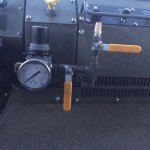Update on my CTIS problem (two blinks from HWY, then all five flashing)
Got the M939A2 parts kit, used everything except one o-ring and the cover plate, everything fit. Total difference in the action of the sleeve valves, they pop back when depressed.
However, no change in the original problem. I checked the overboard vent tube and it's clear.
When I power up the truck (with shop air at 125psi), no noises, just the lights. When I de-power the truck, the pressure valve inside the cab pops (the one on the side of the PCU).
QQQ: Does anyone have a step-by-step guide of the operation of the CTIS computer and the PCU, electrically and pneumatically? I've got about six different versions of the Spicer troubleshooting guide, but I work very good at decomposing and troubleshooting a problem if I know in detail how it should be working when it is operational. (fixed an Allison RV transmission and a Dodge 3/4T diesel transmission that way)
Something along the lines of:
1. CTIS box powers on.
2. CTIS waits for pressure switch on wet tank to close
3. CTIS sends signal to PCU switch to check atmo press.
4. CTIS checks pressure on PCU
5. CTIS sends xxx psi to QRV
(something along those lines)
So I can figure out what should have happened when the CTIS flashes HWY and then five flashing, but no noises or pressure checks.
THX!
And good call on the M939A2 parts!


